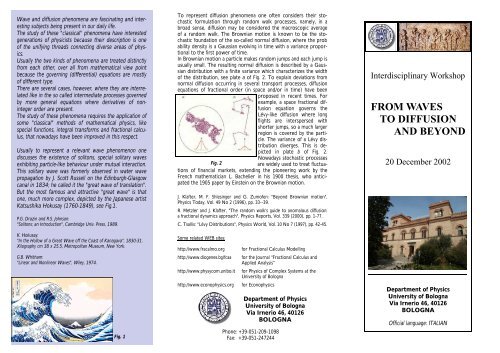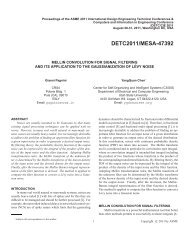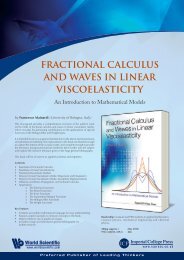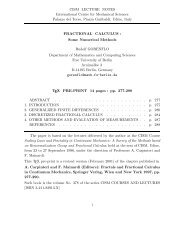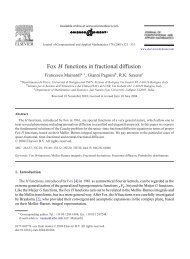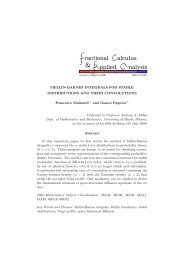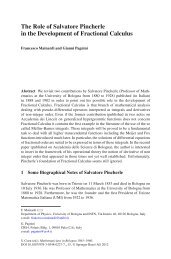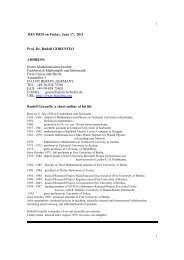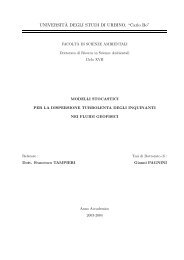from waves to diffusion and beyond - FRActional CALculus MOdelling
from waves to diffusion and beyond - FRActional CALculus MOdelling
from waves to diffusion and beyond - FRActional CALculus MOdelling
Create successful ePaper yourself
Turn your PDF publications into a flip-book with our unique Google optimized e-Paper software.
Wave <strong>and</strong> <strong>diffusion</strong> phenomena are fascinating <strong>and</strong> interesting<br />
subjects being present in our daily life.<br />
The study of these "classical" phenomena have interested<br />
generations of physicists because their description is one<br />
of the unifying threads connecting diverse areas of physics.<br />
Usually the two kinds of phenomena are treated distinctly<br />
<strong>from</strong> each other, over all <strong>from</strong> mathematical view point<br />
because the governing (differential) equations are mostly<br />
of different type.<br />
There are several cases, however, where they are interrelated<br />
like in the so called intermediate processes governed<br />
by more general equations where derivatives of noninteger<br />
order are present.<br />
The study of these phenomena requires the application of<br />
some "classical" methods of mathematical physics, like<br />
special functions, integral transforms <strong>and</strong> fractional calculus,<br />
that nowadays have been improved in this respect.<br />
Usually <strong>to</strong> represent a relevant wave phenomenon one<br />
discusses the existence of soli<strong>to</strong>ns, special solitary <strong>waves</strong><br />
exhibiting particle-like behaviour under mutual interaction.<br />
This solitary wave was formerly observed in water wave<br />
propagation by J. Scott Russell on the Edinburgh-Glasgow<br />
canal in 1834; he called it the "great wave of translation".<br />
But the most famous <strong>and</strong> attractive "great wave" is that<br />
one, much more complex, depicted by the Japanese artist<br />
Katsushika Hokusay (1760-1849), see Fig.1.<br />
P.G. Drazin <strong>and</strong> R.S. Johnson:<br />
"Soli<strong>to</strong>ns; an Introduction", Cambridge Univ. Press, 1989.<br />
K. Hokusay:<br />
"In the Hollow of a Great Wave off the Coast of Kanagava", 1830-31.<br />
Xilography cm 38 x 25.5, Metropolitan Museum, New York.<br />
G.B. Whitham:<br />
"Linear <strong>and</strong> Nonlinear Waves", Wiley, 1974.<br />
Fig. 1<br />
To represent <strong>diffusion</strong> phenomena one often considers their s<strong>to</strong>chastic<br />
formulation through r<strong>and</strong>om walk processes, namely, in a<br />
broad sense, <strong>diffusion</strong> may be considered the macroscopic average<br />
of a r<strong>and</strong>om walk. The Brownian motion is known <strong>to</strong> be the s<strong>to</strong>chastic<br />
foundation of the so-called normal <strong>diffusion</strong>, where the prob<br />
ability density is a Gaussian evolving in time with a variance proportional<br />
<strong>to</strong> the first power of time.<br />
In Brownian motion a particle makes r<strong>and</strong>om jumps <strong>and</strong> each jump is<br />
usually small. The resulting normal <strong>diffusion</strong> is described by a Gaussian<br />
distribution with a finite variance which characterizes the width<br />
of the distribution, see plate a of Fig. 2. To explain deviations <strong>from</strong><br />
normal <strong>diffusion</strong> occurring in several transport processes, <strong>diffusion</strong><br />
equations of fractional order (in space <strong>and</strong>/or in time) have been<br />
proposed in recent times. For<br />
example, a space fractional <strong>diffusion</strong><br />
equation governs the<br />
Lévy-like <strong>diffusion</strong> where long<br />
flights are interspersed with<br />
shorter jumps, so a much larger<br />
region is covered by the particle.<br />
The variance of a Lévy distribution<br />
diverges. This is depicted<br />
in plate b of Fig. 2.<br />
Fig. 2<br />
Department of Physics<br />
University of Bologna<br />
Via Irnerio 46, 40126<br />
BOLOGNA<br />
Phone: +39-051-209-1098<br />
Fax: +39-051-247244<br />
Nowadays s<strong>to</strong>chastic processes<br />
are widely used <strong>to</strong> treat fluctua-<br />
tions of financial markets, extending the pioneering work by the<br />
French mathematician L. Bachelier in his 1900 thesis, who anticipated<br />
the 1905 paper by Einstein on the Brownian motion.<br />
J. Klafter, M. F. Shlesinger <strong>and</strong> G. Zumofen: "Beyond Brownian motion",<br />
Physics Today, Vol. 49 No 2 (1996), pp. 33--39.<br />
R. Metzler <strong>and</strong> J. Klafter, "The r<strong>and</strong>om walk's guide <strong>to</strong> anomalous <strong>diffusion</strong>:<br />
a fractional dynamics approach", Physics Reports, Vol. 339 (2000), pp. 1-77.<br />
C. Tsallis: "Lévy Distributions", Physics World, Vol. 10 No 7 (1997), pp. 42-45.<br />
Some related WEB sites:<br />
http://www.fracalmo.org for Fractional Calculus Modelling<br />
http://www.diogenes.bg/fcaa for the Journal "Fractional Calculus <strong>and</strong><br />
Applied Analysis”<br />
http://www.physycom.unibo.it for Physics of Complex Systems at the<br />
University of Bologna<br />
http://www.econophysics.org for Econophysics<br />
Interdisciplinary Workshop<br />
FROM WAVES<br />
TO DIFFUSION<br />
AND BEYOND<br />
20 December 2002<br />
Department of Physics<br />
University of Bologna<br />
Via Irnerio 46, 40126<br />
BOLOGNA<br />
Official language: ITALIAN
An INTERDISCIPLINARY WORKSHOP on the subject<br />
"FROM WAVES TO DIFFUSION AND BEYOND"<br />
will be held on Friday, December 20, 2002 at the Department<br />
of Physics, University of Bologna, Via Irnerio 46,<br />
40126 BOLOGNA.<br />
Official language: ITALIAN<br />
On the occasion of the 60th birthday of Prof. Francesco<br />
Mainardi (Teacher <strong>and</strong> Researcher in Mathematical Physics<br />
at the University of Bologna) his former students <strong>and</strong> Italian<br />
collabora<strong>to</strong>rs have agreed <strong>to</strong> meet <strong>and</strong> discuss <strong>to</strong>gether<br />
their scientific <strong>and</strong> professional interests.<br />
The title of the workshop somehow reflects the various<br />
<strong>to</strong>pics treated by Mainardi <strong>and</strong> his co-workers, <strong>from</strong> problems<br />
of wave propagation <strong>and</strong> <strong>diffusion</strong> <strong>to</strong> special functions,<br />
fractional calculus <strong>and</strong> r<strong>and</strong>om walk models applied <strong>to</strong> finance<br />
(econophysics).<br />
Anyone wishing <strong>to</strong> attend is kindly requested <strong>to</strong> send an email<br />
by Saturday, December 14 <strong>to</strong>: info@fracalmo.org<br />
specifying his/her affiliation, date of arrival/departure.<br />
This will help the organizers with catering arrangements<br />
(coffee breaks) <strong>and</strong> lecture room availability.<br />
For arrangements of the last minute, please call 051-209.1098<br />
F. Mainardi lecturing on Fractional Calculus at MaPhyS<strong>to</strong><br />
Center, Univ. Aarhus, January 2000.<br />
Credit: MaPhyS<strong>to</strong> News No. 4, February 2000, Fig. 12, p. 9, http://www.maphys<strong>to</strong>.dk/<br />
ORGANIZING COMMITTEE:<br />
Enrico SCALAS (Chairman),<br />
Claudia DAFFARA, Ombretta PINAZZA, Giuliano VITALI<br />
Program<br />
20.12.02 Morning AULA B<br />
1. Morning Session on Mathematical Physics <strong>and</strong> Modelling<br />
Chair: Piero OLLA (ISAC-CNR, Lecce)<br />
09:15 - 09:20 OPENING by Enrico SCALAS (DISTA, Università<br />
del Piemonte Orientale, Aless<strong>and</strong>ria)<br />
09:20 - 09:40 Gianni PAGNINI (Istitu<strong>to</strong> ISAC-CNR, Bologna):<br />
Special Functions via Mellin-Barnes Integrals<br />
09:40 - 10:00 Paolo PARADISI (Istitu<strong>to</strong> ISAC-CNR, Lecce):<br />
Dynamics of Solid Particles in Turbulent Flows<br />
10:00 - 10:20 Silvana DI SABATINO (Dip. Scienze Materiali, Università,<br />
Lecce): Modelling Pollution Dispersion in Urban Areas<br />
10:20 - 10:40 Dino ZARDI (Dip. Ing. Civile Ambientale, Università,<br />
Povo-Tren<strong>to</strong>): Dynamics of Mountain <strong>and</strong> Valley Winds<br />
10:40 - 11:00 Fabio CAVALLINI (Istitu<strong>to</strong> Nazionale Oceanografia<br />
e Geofisica Sperimentale - OGS, Sgonico, Trieste): Causal Generalized<br />
Functions in Geophysical <strong>and</strong> Environmental Modelling<br />
11:00 - 11.20 COFFEE BREAK<br />
2. Morning Session on Mathematical Physics <strong>and</strong> Modelling<br />
Chair: Maria Carla TESI (Dip. Matematica, Università, Bologna)<br />
11:20 - 11:40 Daniele MORETTI - Aless<strong>and</strong>ro VIVOLI (Dip. Fisica,<br />
Università, Bologna): R<strong>and</strong>om Walks <strong>and</strong> Fractional Diffusion<br />
11:40 - 12:00 Claudia MANZONI - Ombretta PINAZZA (Dip.<br />
Fisica, Università - INFN, Bologna): Self-Similar S<strong>to</strong>chastic Processes<br />
12:00 - 12:20 Michele BALDINI (Dept. Physics, New York University,<br />
New York, USA): Recent Developments on the S<strong>to</strong>chastic<br />
Burgers Equation<br />
12:20 - 12:40 Giuliano VITALI - Dip. Scienze e Tecnologie Agro<br />
Ambientali, Università, Bologna): Mathematical Physics in Surface<br />
Hydrology<br />
12:40 - 13:00 Massimo TOMIROTTI (Dip. Ing. Civile, Università,<br />
Brescia): Hyperbolic Conservation Laws <strong>and</strong> Applications <strong>to</strong> the<br />
Dam-Break Problem<br />
13:00 - 14:30 LIGHT LUNCH<br />
20.12.02 Afternoon AULA A<br />
1. Afternoon Session on Finance/Econophysics <strong>and</strong> Management<br />
Chair: Maria I. LOFFREDO (Dip. Scienze Matematiche e<br />
Informatiche, Università, Siena)<br />
14:30 - 15:00 Domenico CAVALIERE (LEK Consulting, Milano):<br />
From Physics <strong>to</strong> Management <strong>and</strong> Consulting<br />
15:00 - 15:30 Gian-Italo BISCHI (Istitu<strong>to</strong> Scienze Economiche,<br />
Università, Urbino):<br />
Dynamic Modelling <strong>and</strong> Complexity in Economics<br />
15:30 - 16:00 Donatella TOCCI (Banca FINECO, Reggio Emilia):<br />
The Talent<br />
16:00 - 16:20 COFFEE BREAK<br />
2. Afternoon Session on Finance/Econophysics <strong>and</strong> Management<br />
Chair: Eduardo ROMAN (Dip. Fisica - INFN, Milano)<br />
16:20 - 16:40 Enrico GRASSI (Liceo Scientifico, San Marino):<br />
S<strong>to</strong>ck Market Trends: the Behaviour of a Chartist<br />
16:40 - 17:00 Gianni DE FABRITIIS (ATALab, Firenze):<br />
On Size <strong>and</strong> Growth of Business Firms<br />
17:00 - 17:30 Enrico SCALAS (Dip. Scienze e Tecnologie Avanzate,<br />
Università del Piemonte Orientale, Aless<strong>and</strong>ria):<br />
On the Role of Phenomenological Models in Finance<br />
17:30 - 18:00 Marco RABERTO (Dip. Ing. Biofisica ed Elettronica,<br />
Università, Genova): Agent-Based Computational Economics:<br />
A New Mainstream in Econophysics<br />
18:00 - 18:20 Claudia DAFFARA (Dip. Fisica, Università - ENEA,<br />
Bologna): The WEB site www.fracalmo.org<br />
18:20 - 18:30 CONCLUSIONS by F. Mainardi (Dip. Fisica, Università<br />
- INFN, Bologna)<br />
SOCIAL DINNER<br />
20:00 at Restaurant Donatello, Via A. Righi 8, 40126 Bologna<br />
Tel 051.23.54.38 (Menu - Cucina Bolognese)


